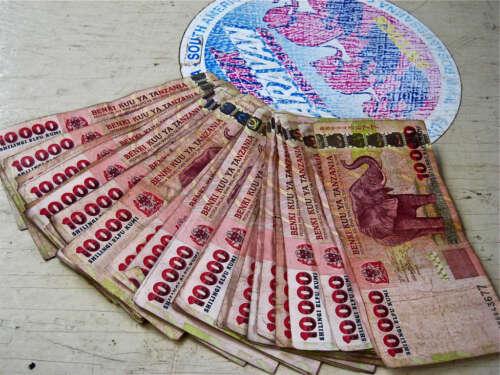- Africa’s new dawn: the rising role of digital and AI in agriculture
- Can Dangote Refinery Transform Africa Energy Ambition
- Gallup Survey: 80 per cent of Kenyan Workers Are Disengaged and Seek New Opportunities
- Madagascar Man Freed from 5KG Tumor After 15-Year Struggle
- How women in Africa are perceived and treated
- Sugar consumption in Kenya to Increase to 1.23 Million Tonnes
- Can Somalia and Turkey Oil deal Bring Change in Somaliland
- Remittances to Kenya dropped to $371.6 million in June, marking a six month low
Browsing: Banking in Tanzania
- Tanzania-based CRDB bank has recognized the potential for growth opportunities in regional economies.
- CRDB Bank has established a presence in Burundi, Rwanda, Uganda, and DRC, following in the footsteps of Kenya’s Equity and KCB.
- CRDB Bank’s regional expansion aims to facilitate cross-border trade and enhance financial inclusion.
CRDB Bank is evolving into a partner for growth for East Africa’s entrepreneurs by seeking to replicate its success story in Tanzania across the regional markets. The bank has recognized the potential for growth and opportunities in neighboring countries and is strategically expanding its operations in East Africa.
In Tanzania, entrepreneurs are tapping into the lender’s range of products to scale into new growth horizons. Take Diana Tarimo for instance. When Diana received about $21,000 in business loans from CRDB, this became the catalyst she needed to expand her water distribution investments in suburban Dar es Salaam.
Diana is one of over 10,000 …
As the world and the East African region continue to recover from different kinds of economic shocks triggered by Covid-19, inflation in Tanzania has also taken different turns. According to the review, in August 2021, twelve-month inflation remained at 3.8 per cent, which is noted to be the same, as the last month.
On the other side of the fence, the review showed that core inflation—of which its index calls of the largest share in consumer price index (CPI), rose to 4.5 per cent in August 2021 from 4.1 per cent in July 2021, this is attributed to the increase in transport costs, “reflecting an upward shift in fuel prices”.
Things seemed to work better in food inflation, whereby annual food inflation—excluding alcoholic beverages, slimmed down to 3.6 per cent from 5.1 per cent, the review argues that this is due to a decrease in prices of maize and maize …
Central Bank of Tanzania
Tanzania Central Bank (Bank of Tanzania) has released it’s monthly economic review bulletin for September 2020, earlier this week, which displayed rather a good prospect for Tanzania’s economy.
The bulletin comes within the same week, when the central bank’s Monetary Policy Committee (MPC) affirmed that Tanzania’s economy will grow by 5.5 per cent in 2020, according to information from The Citizen.
Further, the team noted that—the bank’s accommodative monetary policy was being implemented in a fashion that macroeconomic indicator remained positive, despite the impact of coronavirus (COVID-19) on the global economy.
However, the monthly economic review depicted inflation at a lower level, while exports and foreign exchange reserves remained rather adequate.
Inflation
The report showcased the headline inflation at a stabilized point, standing at 3.3 per cent in August 2020. On a comparison basis, inflation is at a much lower point—than 3.6 per cent in August …
The banking sector in Tanzania has been experiencing a rather significant shift over the past few years.
According to the Bank of Tanzania (BoT) records, 40 registered banks operate in Tanzania, National Microfinance Bank (NMB) inclusively—which is now making a substantial investment in offering seamless banking services across Tanzania.
NMB Bank is one of the biggest banks in Tanzania, with over 13 years of operations in Tanzania. The bank’s ownership is split between the government via the Ministry of Finance, holding 31.8 per cent of the shares, public shareholders taking 21.6 per cent of shares of NMB, with foreign investors taking 3.3 per cent (directly or nominees)
Earlier in October, NMB Bank ushered a newly re-branded mobile platform and its app “Mobile Klik” to improve seamless access to financial services in Tanzania.
NMB Bank serves as robust retail and commercial bank, offering financial services to over 3.5 million customers served …
Tanzania endeavors to become a middle-income economy by 2025 with a desired per capita income of USD 3000; this will be a monumental step towards economic development and growth for the country.
These aspirations can only be achieved by investing in human capital, in particular creating equal opportunities for women and men. Human capital is the driver of economic transformation and according to the National Bureau of Statistics (NBS) the population currently stands at 54 million and is projected to reach 67 million by 2025. Currently, women comprise 51.3 percent of the population, and while they play a key role in household resilience and sustaining livelihoods within Tanzania’s current economy, they face considerable challenges in other areas. For Tanzania to realize its development ambitions to attain middle-income status, these obstacles need to be addressed in order to create a level playing field that empowers women to be involved in the …






![Report Insight: Bank of Tanzania says economy growth modest The Bank of Tanzania. Its September economic review report show the country's modest growth. [Photo/BoT_Pan African Visions.jpg]](https://theexchange.africa/wp-content/uploads/2021/10/BoT_Pan-African-Visions.jpg)
